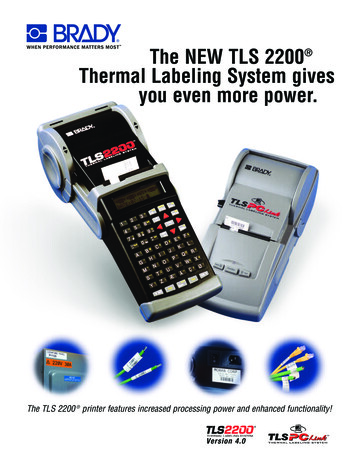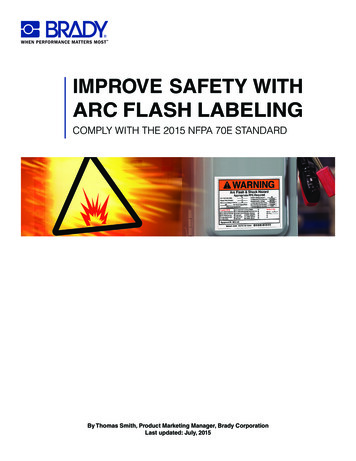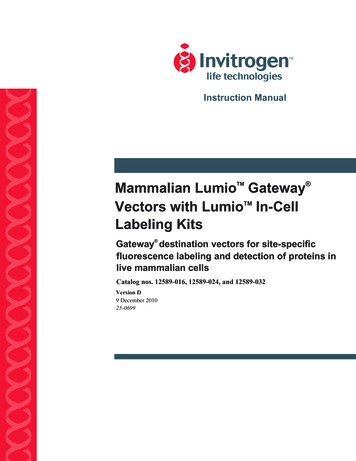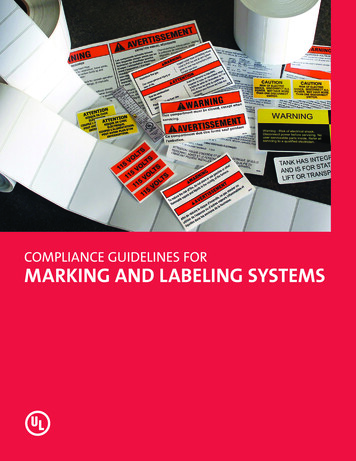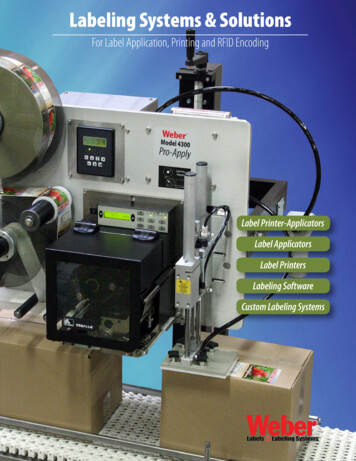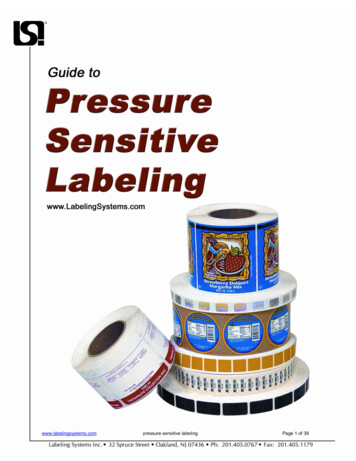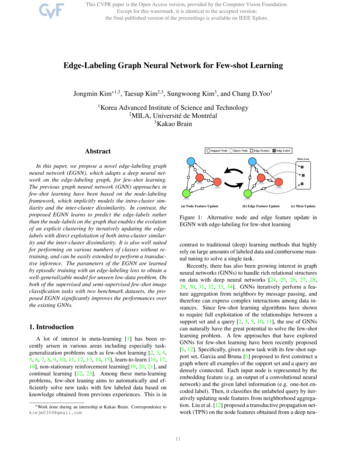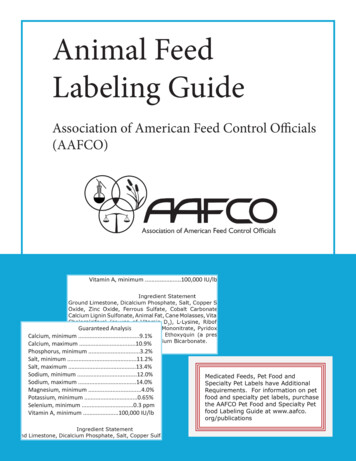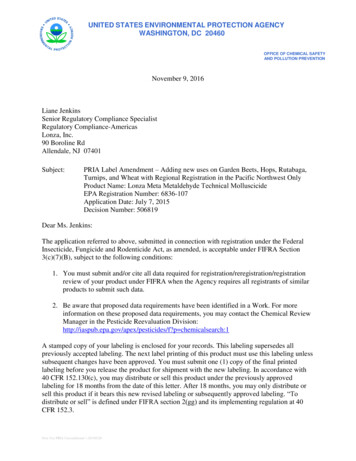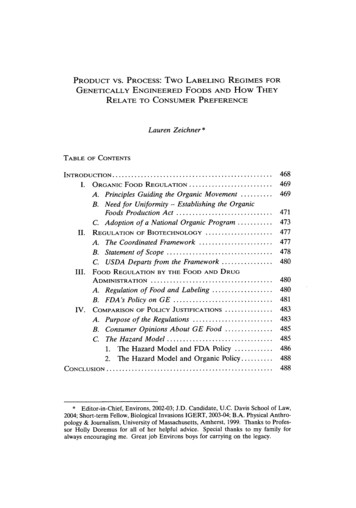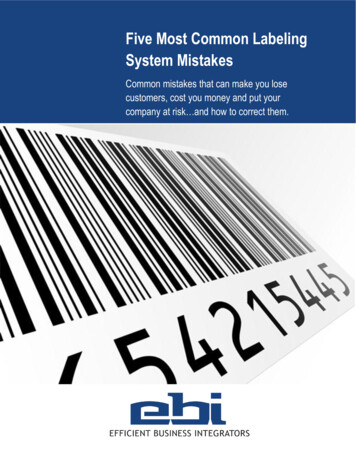
Transcription
Five Most Common LabelingSystem MistakesCommon mistakes that can make you losecustomers, cost you money and put yourcompany at risk and how to correct them.
Table of ContentsIntroduction . 3Five Most Common Mistakes. 4Mistake #1 - Creating One Label File for Each Product. 4The Problem: The ‘one product per label file’ dilemma . 4The Risk: Business interruption, loss of man hours, and mistakes . 5The Solution: Consolidate to one or a few templates and control the process . 6Mistake #2 - Allowing Labels to ‘Evolve’ Out of Compliance . 8The Problem: Lack of consistency causes labels to fall out of compliance . 8The Risk: Returns and rework causing logistical costs, fines, and business disruption . 9The Solution: Formalize and control the process . 10Mistake #3 – Overreliance on Manual Entry . 12The Problem: Manual entry creates opportunity for costly printing errors. . 12The Risk: Product recall, loss of reputation, and legal exposure . 13The Solution: Utilized existing software features to reduce manual entry . 14Mistake #4 – Printing Labels That Require Constant ‘Fine Tuning’ . 16The Problem: Print users constantly adjusting the label format, printer, and supplies . 16The Risk: Decreased Print User productivity and cost of wasted labels and ribbon . 17The Solution: Adopt a best practices approach to label and labeling station setup . 18Mistake #5 – Poor Labeling System Maintenance . 20The Problem: Neglecting your labeling system . 20The Risk: Needless troubleshooting and the Cascading Crisis . 21The Solution: Best practices for Labeling System Maintenance . 22Conclusion . 232 Page
IntroductionAre you at Risk?Production shutdown, hard drive crashes, loss of man hours, lawsuits, government sanction, costlyshipping errors, and customer fines or loss of the customer’s business altogether these all sound scarybut can your labeling system create these problems for you? If your organization labels things, thenmost likely the answer is yes!The problem often sneaks up on you. The accumulation of labeling systemsetup errors may cause a slow drip of wasted tasks and activities in productionwearing away at your company’s profitably. You may not notice the loss ofcompany resources with wasted label materials and unnecessary IT supportcalls. On the other extreme, lack or good labeling system discipline, control,and maintenance can lead to catastrophic system failure. These problems oftenappear to come from nowhere and bring the business to a halt. In either case,Figure 1 - The 'Slow Drip' ofthe risk is hidden but real.Labeling System CostsMost of these issues can be prevented. Many of the ‘slow drip’ problems areeasily solved. Preparing for the catastrophic ones allow you to reduce the downtime from hours or daysto just minutes. In this guide we hope to help you understand the common issues and if they mightaffect you, assess the potential impact to your business, and explain what you can do about it.How to Read this ArticleThe paper is organized around each of the Five Most Common Labeling Mistakes we have seen duringthe last decade. You can look at the Table on Contents and jump around to which ever ones you wantread and read them in any order you choose.Within each ‘Common Labeling Mistake’ we break the content down to the three components listedabove: The Problem, The Risk, and The SolutionIf you feel like you already understand “The Problem” and “The Risk” and just want to move straight to“The Solution”, go ahead! Our hope is you can extract only the information you require quickly andeasily.Why are the Pages Watermarked with “Draft”?This is actually not the final document but our first draft. The new EBI Blog will periodically post onechapter (i.e. one labeling mistake) at a time to get the information out to our clients and solicit theirfeedback. We will take the feedback and then go back and update this document. Most of what welearned in this business came from working with our clients. We look to our clients to help us with thisdocument as well.3 Page
Five Most Common MistakesMistake #1 - Creating One Label File for Each ProductThe Problem: The ‘one product per label file’ dilemmaAs companies grow, especially ones that grow fast, they must prioritize. Product labeling can be anafterthought in the rush to get products out the door. Often, the process of creating a label for a newproduct is not really a process at all. Someone simply takes the label file of a similar product, copies it,updates it, and saves it.It makes sense. By copying the last file, we assumethe overall layout is the same. Hopefully it stayswithin the original guidelines dictated by thecustomer or by internal company standards (often inMarketing or Quality Assurance). The user makesmany assumptions when doing it this way. But, whenyour priority is to get the product out the door, this isoften the way labeling gets done.Figure 2 - Sample label as a company adds more SKUs,they often will copy this format over and over again butthis approach is likely to cause problems over time!This practice can go on for years and we have seenclients accumulate hundreds and even thousands oflabel templates this way. Although not as efficient as it could be, most clients don’t really consider this aproblem until a global label change requires the update of ALL the labels. Example of global changes caninclude: Change of physical address (if address is listed on the label)Government mandates (i.e. CRF 21 Part 11)A company merger or takeoverSoftware upgradesCustomer mandates4 Page
The Risk: Business interruption, loss of man hours, and mistakesLabor is usually one of the highest costs a company faces. Downtime for individual or group results inadditional and unnecessary labor costs. Losses may become catastrophic when the downtime reachesacross departments or the entire organization.Individual Labor CostsCompleting one of the ‘global change events’ mentioned above usually means someone needs to open,update, verify, and save EVERY label file ONE BY ONE. If the number of files reaches into the hundreds(and they often do), this will take MANY hours. Regardless if this task is taken all at once or spread overdays, weeks, and months, the cost is real and effects the company’s bottom line.Downtime across the Entire OrganizationComputer system failures, such as a hard drive crash, can start a costly Cascading Crises (see Mistake #5– Poor Labeling System Maintenance) that can interrupt your business operations across the entiredepartments or the entire organization. A LeanManufacturing operation deploying Just in Timemanufacturing processes can quickly idle as the ITDepartment hurriedly tries to restore and update oldrecovered files or recreate them from scratch. Thedowntime is exacerbated when dealing with a largevolume of label files. Regardless of your ability torecover old files, the recovery is likely to take valuabletime.Errors in RebuildingAs human beings, we make mistakes. The stress and pressure of rebuilding the label files quickly andkeeping up with other job responsibly increases the likelihood of making mistakes. The repetition ofupdating hundreds of labels under these conditions makes mistakes inevitable. Since we cannot predictwhen or where these mistakes occur we won’t find them until an alert operator spots them duringproduction or downstream in the supply chain where the penalties can be costly.5 Page
The Solution: Consolidate to one or a few templates and control the processHow Label File Consolidation WorksInstead of creating a new label file for each product, we recommend standardizing on one or a smallhandful of label templates that can be reused for different (but usually similar) products. All the majorbrands of industrial labeling software have the ability to use variable or fixed fields in the label file. Thusthe client can create a ‘template label file’ where all the data fields common to each product (companyname, logo, address, etc.) are saved as fixed fields. Data fields that vary depending on the part numberare saved as variable fields.Figure 3 - Example of label template using variable fields in CODESOFT by TEKLYNXThe printing process works like this the user enters or scans a ‘key field’ (usually a part number) intothe software. The software connects to a database (often in an ERP or accounting system) and uses thatkey field (i.e. part number) to look up other data that belongs on the label. Fields such as itemdescription, case pack, weight, size, color, etc. are pulled from the database. The labeling softwareinstantly populates the variable data fields on the label with this information and then voila! The labelprints perfectly.Adding New Products Gets EasierNeed to add a new product? There is no need to create a new label. All we need to do is add that newproduct information to the database. We can be absolutely sure that all labels using that template willprint the same every time.How to you know which files should be consolidated to templates? Look for labels with: The same physical dimensions (i.e. all 4” x 6” labels)Similar general rendering or layout of fieldsUse of the same data elements: logo, product description, etc.6 Page
Stopping the ‘One Label File for Each Product’ Problem from ReoccurringTo help enforce the use of just a few‘approved’ templates, many labelingsoftware companies offer ways tocontrol access to the templates. Fornetworked environments, thesetemplates can often be stored in asecured database (like SQL) that canbe centralized, protected, and backedup.At EBI, we can help clients setup thesesystem and can help automate theconsolidation process.Figure 4 - Example of using software to centralize and control the label creation,printing, and approval process."Checking Out" a label from the LABEL ARCHIVESQL database.7 Page
Mistake #2 - Allowing Labels to ‘Evolve’ Out of ComplianceThe Problem: Lack of consistency causes labels to fall out of complianceMost see product labeling as an operation performed from a PCnear a printer. Even on many automated assembly lines, theprinter and label applicator are driven by a local “controller”.This controller is typically a PC running the labeling softwarewith a serial or USB connection direct to the printer andapplicator.Label System Setup Can Encourage Label InconsistenciesThere are many options, but for a majority of clients (especiallyFigure 5 - ID Technology 250N label printer andsmall to medium sized operations), the PC is licensed withapplicator (controller not present)labeling software that has full capabilities to create, modify, andprint a label. Therefore the person starting the print job also has the ability to alter the label and savethose results. This is where we often see label start to ‘evolve’. Either intentionally or unintentionallyminor changes to the label are made and, over time, confusion arises over the requirements of theoriginal label design. Reasons for these changes include: Trying to make the label ‘look right’ before a production runCopying or sharing files to multiple PCs and losing track of which version is ‘correct’Accidentally deleted fields or scrambled database connectionsAs a consequence, the label format or template eventually falls out of compliance.8 Page
The Risk: Returns and rework causing logistical costs, fines, and business disruptionCustomer FinesMajor retailers (Wal-Mart, Kmart, Target, etc.) will fine their customers who are out of complianceeither directly (fee charged deducted from invoices) or indirectly (through shipping costs for immediateexpedited reshipment of new merchandise and return of non-conforming items). Either way thesupplier is stuck with the bills as well as the internal cost of interruptions in production and thewarehouse to get the new product out the door quickly and rework the returning items.Government Compliance MandatesFor companies involved in the production of regulated items such aschemicals, pharmaceuticals, food, or any product where mislabeling can causeharm to the workers or public label control becomes an absolute requirementand subject to government mandates. Mandates include local standards onwhat information is provided and how it is provided on labels. Internationalinitiatives such as GHS, or Global Harmonized System of Classification andLabeling of Chemicals, not only specify labeling standards to protectconsumers but also seek to protect workers by requiring companies to clearlyidentify product hazards within the company and supply chain. Labeling isconsidered a critical part of these mandates and these mandates can carryFigure 6 - GHS "Purple Book" heavy financial and legal penalties.Mandating the Process as Well as the Label FormatsGood Manufacturing Practice (orGMPs) seek to protect workers and thepublic and involve labeling standards.By requiring these practices,government expect organizations tonot only stay in compliance withspecific label format requirements butalso be able to demonstrate effectivedocument control practices to preventthese types of problems in the firstplace.Figure 7 - FDA Code of Federal Regulations Title 21 Part 11A good example is the FDA guidelineslaid out in CFR 21 Part 11. In thissection, the FDA gives guidance as to what types of procedures they expect to see for proper usage andstorage of electronic documents for companies under their jurisdiction. This PC based system describedabove runs the risk of failing an audit since there are so many opportunities for human error and failure.9 Page
The Solution: Formalize and control the processTo keep label flies from evolving out of compliance, theorganization should impose a strict process for labelcreation and approval. Effective processes we have seeninclude participation of the following departments: Quality AssuranceMarketingProductionInformation TechnologyThe Role of Quality Control, GMPs, and GHSQuality Assurance or Quality Control departments often start the process. As with other elements ofthe product, QA and QC departments should require strict process controls and follow the sameapproval process as other elements of product quality control. Effective quality control not only insuresthat labeling conforms to the same standards of quality and consistency required of the product, it alsoneeds to guarantee compliance with customer and government mandates. When done correctly, thisapproach protects the brand and company reputation as well as lowers costs.The Role of MarketingMarketing is also often involved in this process. The labeling (product, case, and pallet) are allconsidered part of the product and often first element of the product the client sees. As part of theapproval process for a new or changed product, marketing will evaluate the way the label looks andinsure it meets customer requirements and expectations.10 P a g e
The Roles of Production and Information TechnologyProduction must execute the labeling requirements correctly and consistently. They often work closelywith IT to make sure IT related equipment prints the correct labelat the correct time. Controls must be in place to make sure thecorrect label file is selected and the correct variable data (lotnumber, serial number, date codes, etc.) are applied to the correctproduct batches.Most industrial labeling software companies offer add-ons orupgrades to their software that will facilitate this control process.The software can allow for clients to centralize and control theprocess of label creation, label approval, and label printing. Inthese systems, the label files are stored in a centralized location foreasy access and backup purposes. Users log into the system togain access to the files. The level of access is controlled bypredefined set of permissions set by the system administrator. InFigure 8 - TEKLYNX CENTRAL CFR is anmany cases, the software will also provide an audit trail trackingexample of software designed to helpclients keep labels in compliance.who printed what label with what data at what time.11 P a g e
Mistake #3 – Overreliance on Manual EntryThe Problem: Manual entry creates opportunity for costly printing errors.People make mistakes. Even though this is common knowledge, many companies rely unnecessarily onusers to manually enter data during the label setup and printing process. Often this is variable data suchas date codes, lot codes, and serial numbers. Usually, we find, this data is either located in anothersystem (and the user transfers it manually) or is the result of an algorithm the user performs at printtime (such as definite a serial number like this, MM-DD-001, where MM is month, DD is date, and 001 isa serialized number applied for just that date).Industrial labeling software is usually designedpopulate these data fields automatically. Humanintervention is eliminated or minimized. Data thatneeds to on the label that can be found inside theclient’s ERP system, for example, can be pulleddirectly from the system’s database using severalmethods (ODBC link, SQL queries, XML file, etc.).Users can also program the software to calculatecomplex algorithms using data available on theexisting computer network such as PC location,logged in user, and system clock.Even though these capabilities exist in the software, we find a vast majority of our users are not awareof them or don’t have the expertise in house to setup the label so they can be utilized.12 P a g e
The Risk: Product recall, loss of reputation, and legal exposureBy not fully using the capabilities of the software, we find clients are adding risks to their operations.Mistakes caused by user error can come from: Poor employee trainingLack of oversight and controlsBeing humanUser Error is InevitableEven if a client establishes and maintains a comprehensive employee training program and tightens andenforces oversight and control over the process we still can have errors due to the third mistake sourcelisted above. We are human. As humans we have great powers of imagination and creativity but we arenot built to do the exact same thing over and over again without the possibility of error. The possibilityof hitting the wrong key, remembering the date incorrectly, a misstep when picking the right labelformat, plus a host of other potential slipups continues to exist.How Automation and Turn a Small Error into a Big ProblemSome companies specialize in helping organization create and execute product recall plans and mostwarn of the critical and costly makes from labeling errors. Ironically the most automated operations canbe the most vulnerable to human error. A mistake by one person setting up the labeling for a productcan, through the speed and effectiveness of automation, multiply itself over hundreds or thousands ofproducts. Especially if the client’s internal system of tracking the production and shipping of products isweak, the cost of the recall can be devastating in direct recall costs and interruption in business.Business RiskFigure 9 - Dennis Quaid sued Baxterover Heparin product labeling13 P a g eIt is not hard to see the business risk with mislabeling. Consumerproduct and medical device companies carry an especially high risk oflegal troubles when mistakes are made. Organizations that make anddistribute expensive or heavy items can face costly recalls. Allorganizations carry the risk of a damaged reputation which significanteven if hard to calculate. Driving out opportunities for user error canbe a simple and cost effective way to reduce this risk.
The Solution: Utilized existing software features to reduce manual entryThe owner of the labeling system can look to several categories for ideas on how to reduce the relianceon human input: Use the Software or Hardware (not the Print User) to Collect DataAllow the Software to Calculate Variable DataConsolidate Multiple Label Files into a Few TemplatesHave ‘System Events’ Trigger Label PrintingUsing Software to Control User PermissionsUse the Software or Hardware to Collect the DataRekeying data is more than just a redundant activity. It also creates the opportunity for human errorand costly mistakes. Most labeling systems that we see use data that already exists somewhere else inthe network. Data such as basic product information, such as description, case pack, weight, size, etc.,provides a simple but commonly seen example.Typically you can find all of this information in theProduct Master or Item Master of your accountingor ERP system. Nearly every industrial labelingsoftware application we have seen has the abilityto pull data from another data source based on a‘key field’ or value. For this example, most wouldchoose the product part number as the key field.The software looks into the table in the hostdatabase for the Part Number key field and, oncefound, pulls out all the other data related to thatkey field.Figure 10 - EBI Smart Pallet Label SystemHardware can automatically collect data without human intervention as well. Scanners, as seen inSmart Pallet Labeling Systems, can pick-up data on a box, case, or pallet and use this data to trigger theprinting of a label and populate the label with the correct data. Combined with software integrationmentioned above, we not only make sure the data on the label is populated without manual entry, wealso take the possibly of manually entered mistakes out of labeling printing and confirmation process.Allow the Software to Calculate Variable DataIn some cases, the labeling software cannot pull the data from an existing source because the data isvariable at print time. Manufacturers commonly utilize this feature to create product expiration dates,lot codes, serial numbers, etc. Often these codes include variable data such as the current time anddate, manufacturing location, or machine operator. The design of these codes can be very clever andintricate telling you a lot about the product. From our experience, most labeling software can calculatethese automatically provided you understand how to build the logarithm into the software settings andyou have the correct edition of the software.14 P a g e
Consolidate Multiple Label Files into a Few TemplatesConsolidating multiple similar label files into one or a few templates is a topic covered in Mistake #1 –Creating One Label File for Each Product. This mistake makes the Overreliance on Manual Entry fromPrint Users mistake worse. Usually, the first manual entry a Print User makes into the labeling system isselecting the correct label file! Eliminating Mistake #1 will reduce or eliminate this potential error.Have ‘System Events’ to Trigger Label PrintingThe Print User makes another no-so-obvious manual entry when they hit the Print button. Printing atthe wrong time or to the wrong printer provides another opportunity for human error. Sometimes wecan eliminate this category of mistakes as well by tying the launch of a print job to a ‘System Event’. Thisevent can be anything including the entry of a sales order into an accounting system, the movement ofproduct down a conveyor, or the scan of an order number on a traveler.Using Software to Control User PermissionsSoftware can control the access and functions available to different users. We have seen this done in acouple different ways. One way is to purchase ‘run time’ editions of the software. Doing this provides asimplistic but sometimes effective way to control access. Since the run-time versions of the software bydefinition do not allow altering of the label file, companies will sometimes deploy workstations on thefloor this way knowing users cannot alter the files even if they wanted to do so. This method can beeffective for relatively small deployments however the costs in licensing and maintenance plus the needfor and centralized solution with medium sized and larger operations require a more sophisticateddifferent approach.This more sophisticated approach involves centralizing the software licensing, deployment, andpermissions into a common server based platform.Users are assigned to different user groups based ontheir job responsibilities. When they log in (or oftenthe software uses existing Windows authentication)Figure 11 - LABEL ARCHIVE provides centralized label fileto the system, the only have the permissions (labelmanagement and controlcreation, label approval, print, etc.) specificallyassigned to that group. Thus a print user cannot accidentally change the label format.Software can not only help prevent errors but can aid the recovery process if an error occurs. Forexample, features build into some software applications can aid in the process of a product recall bytracking who made what labels containing what data on what date. Specific lot codes or serial numbersranges issued during that time or production run can then be tracked down and customers more quicklyidentified.15 P a g e
Mistake #4 – Printing Labels That Require Constant ‘Fine Tuning’The Problem: Print users constantly adjusting the label format, printer, and suppliesA Common ProblemWe see this often with clients.Over time, the organization purchases different printer models and brands and, printing different labelfiles, finds that each print run requires the user to make adjustments.The need to adjust the label commonly springs from one or several issues including: Tight label tolerancesPrinting to a heterogeneous group of printers (different models, brands, etc.)Different workstation environments using different printer driversInconsistent loading of label materialThese adjustments usually must be made before each print run and require the user to run samplelabels before printing the required labels.The Label Fix TrapOften the fine tuning only further complicates the process. Most software applications and thermalprinters offer several ways to adjust the label at print time. This convenience is nice at the time ofprinting and helps the print user to get thelabel print job done. However, applying a fixon one label may push the other labelsout of alignment or other changes in labelquality including contrast, etc. if notapplied consistently. In these cases, theadjustments can actually make theproblem worse. It is very easy to make achange that compensates for oneproblem but causes another. Wecall this the Label Fix Trap.Sometimes we can go fullcircle and find ourselvesfixing the label again wefixed in the first place!Users often Increase ordecrease the heat settings onthe printer to compensate for imagesor text that print too light. This canwork for the current label. But, ifdifferent label or ribbon material is usedlater, the change can create overmodulation. This excessive heat willdistort images and making barcodeunreadable. Scaling back the heat setting todecrease on the next label will then reduce contrast and image quality on the original label.When labels are not loaded in the printer consistently, the user may opt to change the label template toaccommodate for slight shift. If these changes are saved, the next user often needs to change themback for the next roll when the labels are reloaded. This becomes a moving target eventually making italmost impossible to load the label and print it correctly the first time.16 P a g e
The Risk: Decreased Print User productivity and cost of wasted labels and ribbonThe constant tinkering causes lost productivity and increased cost of supplies as the printer user tries tomake each print job come out ‘just right’.Lost Productivity Fighting the Label Fix TrapFor an experienced user with minimal label changes, managers may hardly notice. But the time lostaccumulates over time. If (more likely when) the job is turned over to someone new, that personusually needs to climb the experience curve of making these mistakes. This often makes for a frustratingexperience for the new person since. In addition to learning their other new responsibilities, they needto learn the ins and outs of sophisticated labeling software. Learning how to properly use the thermalprinter itself can be a challenge for the non-technical user.Wasted SuppliesSecond, label material and supplies are wasted during each test print. Some ofthese supplies cost the client significant amounts of money. Even in situationswith a small cost per label, the accumulated cost over time adds up and isunnecessary in many cases. For thermal transfer options, the cost of wastedlabels is also a cost in wasted ribbon since the company typically cannot reuse theribbon. If the running of test labe
The accumulation of labeling system setup errors may cause a slow drip of wasted tasks and activities in production wearing away at your company [s profitably. You may not notice the loss of company resources with wasted label materials and unnecessary IT support calls. On the other extreme, lack or good labeling system discipline, control,
